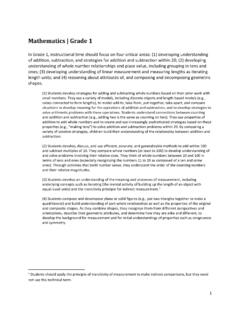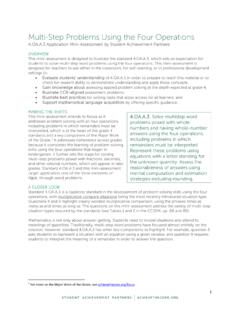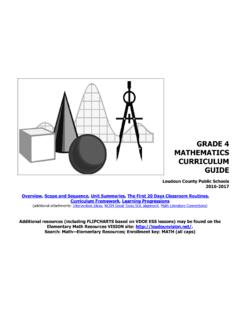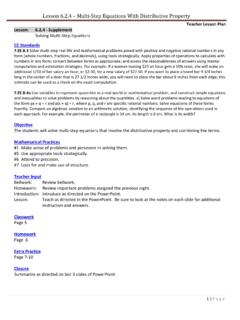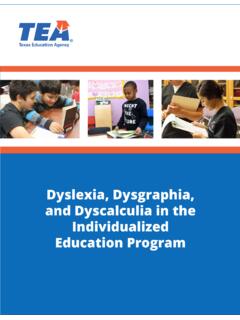Transcription of Mathematics | Grade 4 - Central Rivers AEA
1 1 Mathematics | Grade 4 In Grade 4, instructional time should focus on three critical areas: (1) developing understanding and fluency with multi-digit multiplication, and developing understanding of dividing to find quotients involving multi-digit dividends; (2) developing an understanding of fraction equivalence, addition and subtraction of fractions with like denominators, and multiplication of fractions by whole numbers; (3) understanding that geometric figures can be analyzed and classified based on their properties, such as having parallel sides, perpendicular sides, particular angle measures, and symmetry. (1) students generalize their understanding of place value to 1,000,000, understanding the relative sizes of numbers in each place. They apply their understanding of models for multiplication (equal-sized groups, arrays, area models), place value, and properties of operations, in particular the distributive property, as they develop, discuss, and use efficient, accurate, and generalizable methods to compute products of multi-digit whole numbers.
2 Depending on the numbers and the context, they select and accurately apply appropriate methods to estimate or mentally calculate products. They develop fluency with efficient procedures for multiplying whole numbers; understand and explain why the procedures work based on place value and properties of operations; and use them to solve problems. students apply their understanding of models for division, place value, properties of operations, and the relationship of division to multiplication as they develop, discuss, and use efficient, accurate, and generalizable procedures to find quotients involving multi-digit dividends. They select and accurately apply appropriate methods to estimate and mentally calculate quotients, and interpret remainders based upon the context. (2) students develop understanding of fraction equivalence and operations with fractions. They recognize that two different fractions can be equal ( , 15/9 = 5/3), and they develop methods for generating and recognizing equivalent fractions.
3 students extend previous understandings about how fractions are built from unit fractions, composing fractions from unit fractions, decomposing fractions into unit fractions, and using the meaning of fractions and the meaning of multiplication to multiply a fraction by a whole number. (3) students describe, analyze, compare, and classify two-dimensional shapes. Through building, drawing, and analyzing two-dimensional shapes, students deepen their understanding of properties of two-dimensional objects and the use of them to solve problems involving symmetry. 2 Contents Mathematics | Grade 4 .. 1 Operations and Algebraic Thinking .. 4 Use the four operations with whole numbers to solve problems. ( ) .. 5 Gain familiarity with factors and multiples. ( ) .. 13 Generate and analyze patterns. ( ) .. 16 Number and Operations in Base Ten .. 20 Generalize place value understanding for multi-digit whole numbers. ( ) .. 20 Number and Operations Fractions.
4 29 Extend understanding of fraction equivalence and ordering. ( ) .. 29 Build fractions from unit fractions by applying and extending previous understandings of operations on whole numbers. ( ) .. 34 Understand decimal notation for fractions, and compare decimal fractions. ( ) .. 41 Measurement and Data .. 46 Solve problems involving measurement and conversion of measurements from a larger unit to a smaller unit. ( ) .. 46 Represent and interpret data. ( ) .. 53 Geometric measurement: understand concepts of angle and measure angles. ( ) .. 54 Geometry .. 58 Draw and identify lines and angles, and classify shapes by properties of their lines and angles. ( ) .. 58 Performance Task Example: 75 3 Grade 4 Overview Operations and Algebraic Thinking Use the four operations with whole numbers to solve problems. Gain familiarity with factors and multiples. Generate and analyze patterns. Number and Operations in Base Ten Generalize place value understanding for multi-digit whole numbers.
5 Use place value understanding and properties of operations to perform multi-digit arithmetic. Number and Operations Fractions Extend understanding of fraction equivalence and ordering. Build fractions from unit fractions by applying and extending previous understandings of operations on whole numbers. Understand decimal notation for fractions, and compare decimal fractions. Measurement and Data Solve problems involving measurement and conversion of measurements from a larger unit to a smaller unit. Represent and interpret data. Geometric measurement: understand concepts of angle and measure angles. Geometry Draw and identify lines and angles, and classify shapes by properties of their lines and angles. Mathematical Practices sense of problems and persevere in solving them. abstractly and quantitatively. viable arguments and critique the reasoning of others. with Mathematics . appropriate tools strategically. to precision.
6 For and make use of structure. for and express regularity in repeated reasoning. 4 Operations and Algebraic Thinking Example: The two-eyed space creatures, three-eyed space creatures, and four-eyed space creatures are having a contest to create a group with 24 total eyes. How many two-eyed space creatures are needed to make a group with 24 total eyes? How many three-eyed space creatures are needed to make a group with 24 total eyes? How many four-eyed space creatures are needed to make a group with 24 total eyes? Somebody told the five-eyed space creatures that they could not join the contest. Explain why five-eyed space creatures cannot make a group with 24 eyes. Sample Top-Score Response:12, 8, 6 The five-eyed aliens can only make groups with eyes in a multiple of 5. 5, 10, 15, 20, 25. They will not be able to make a group with 24 eyes. For full credit (3 points): The response demonstrates a full and complete understanding of communicating reasoning.
7 The response contains the following evidence: the student correctly identifies the correct number of two-, three-, and four-eyed aliens needed to make a group with 24 eyes. AND the student correctly explains that the five-eyed aliens cannot make a group with 24 eyes because 5 is not a factor of 24 or because the groups of eyes can only be multiples of 5. For partial credit (2 points): The response demonstrates a reasonable understanding of communicating reasoning. The response contains the following evidence: the student identifies one or two correct numbers of the two-, three-, or four-eyed aliens needed to make a group with 24 eyes. AND the student correctly explains that the five-eyed aliens cannot make a group with 24 eyes because 5 is not a factor of 24 or because the groups of eyes can only be multiples of 5. OR the student identifies the correct number of two-, three-, and four-eyed aliens needed to make a group with 24 eyes. OR the student correctly explains that the five-eyed aliens cannot make up a group with 24 eyes because 5 is not a factor of 24 or because the groups of eyes can only be multiples of 5.
8 For partial credit (1 point): The response demonstrates a partial understanding of communicating reasoning. The response contains the following evidence: the student identifies one or two of the correct numbers of two-, three-, or four-eyed aliens 5 needed to make a group with 24 eyes. OR the student does not provide explanation for why the five-eyed aliens cannot make a group with 24 eyes. Use the four operations with whole numbers to solve problems. ( ) a. Example: Tanya ran 400 meters on Tuesday. She ran 800 meters on Wednesday. What is the total number of meters Tanya ran on these two days? Item Claim Domain Target DOK CONTENT MP Key #1 1 OA, NBT A 2 , N/A 1200 Item Claim Domain Target DOK CONTENT MP Key #31 3 3B, 2D 2 , , 12,8,6 6 1. Interpret a multiplication equation as a comparison, , interpret 35 = 5 7 as a statement that 35 is 5 times as many as 7 and 7 times as many as 5. Represent verbal statements of multiplicative comparisons as multiplication equations.
9 ( ) (DOK 1,2) a. Example: Solution (DOK 2) b. Example: Solution (DOK 1) c. Example: Scott is reading a book that has 172 pages. Melanie is reading a book that has three times as many pages as Scott s book. How many pages does Melanie s book have? Select all the equations that represent this problem . 7 Item Claim Domain Target DOK CONTENT MP Key #10 4 OA E 2 , 4 1. Multiply or divide to solve word problems involving multiplicative comparison, , by using drawings and equations with a symbol for the unknown number to represent the problem , distinguishing multiplicative comparison from additive ( ) (DOK 1,2) a. Example: Solution (DOK 2) 1 See Glossary, Table 2. 8 b. Example: Some students are painting this backdrop for the school play. The backdrop is taped off into 12 equal sections for the students to paint. Mark paints 2 times as much as Jill. Sam paints 3 times as much as Lou.
10 Lou paints 1 section less than Mark. Jill paints 112 of the backdrop. Write the fraction of the backdrop that still needs painted. c. Example: A cat has 2 times as many toys as a puppy. The cat has 12 toys. How many toys does the puppy have? Item Claim Domain Target DOK CONTENT MP Key #21 1 OA A 2 N/A . 6 d. Example: The cost of buying a movie is 4 times the cost of renting a movie. It costs $20 to buy a movie. What is the cost, in dollars, of renting a movie? Item Claim Domain Target DOK CONTENT MP Key #15 1 OA A 2 N/A 5 Item Claim Domain Target DOK CONTENT MP Key #27 4 NF, OA A 2 , 2 e. Solve multistep word problems posed with whole numbers and having whole-number answers using the four operations, including problems in which remainders must be interpreted. Represent these problems using equations with a letter standing for the unknown quantity. Assess the reasonableness of answers using mental computation and estimation strategies including rounding.


